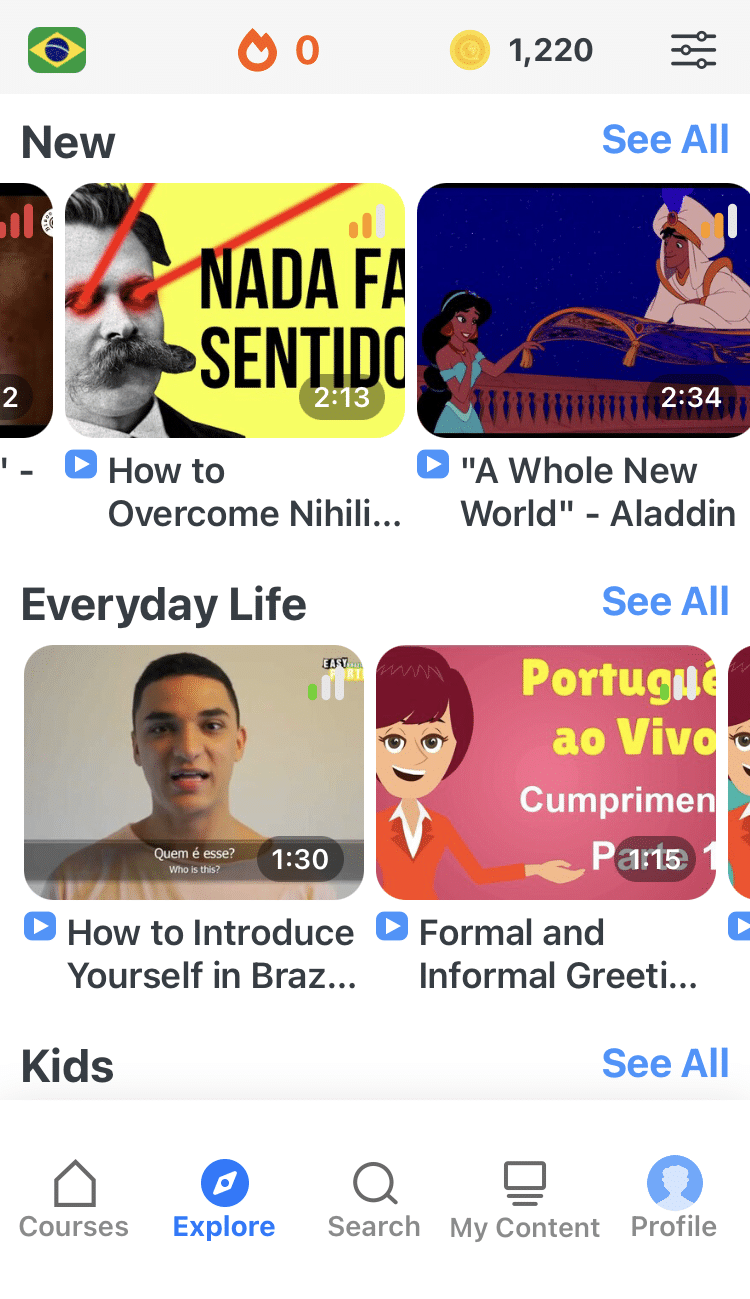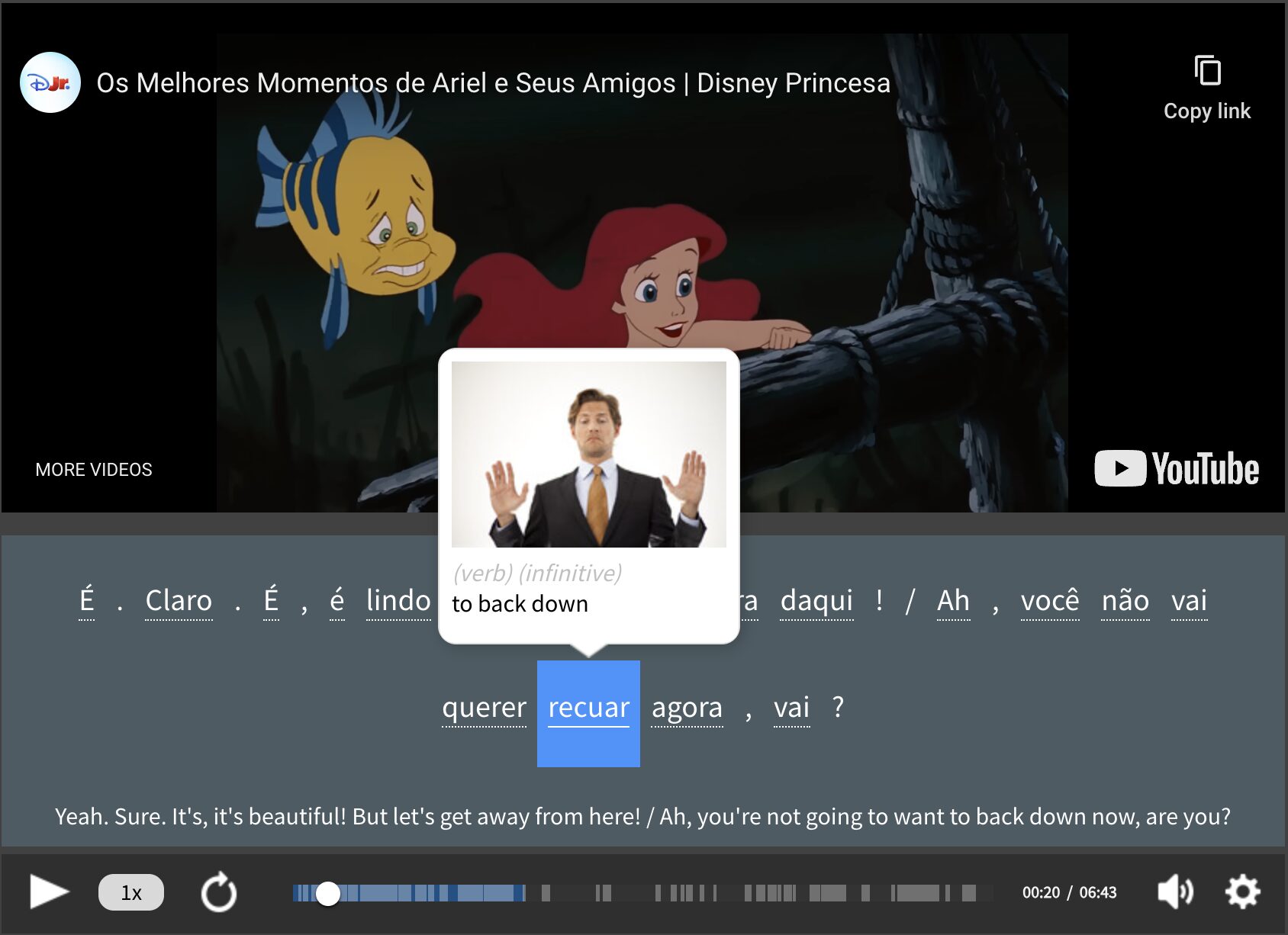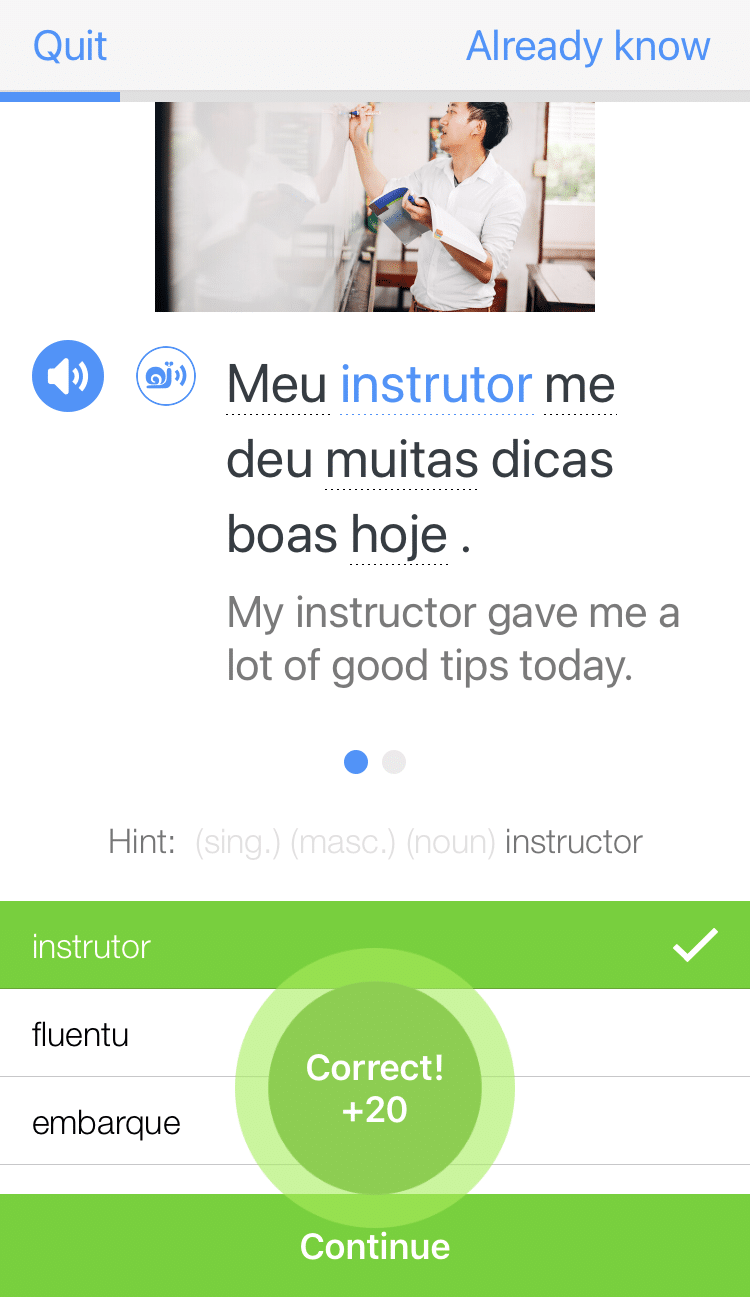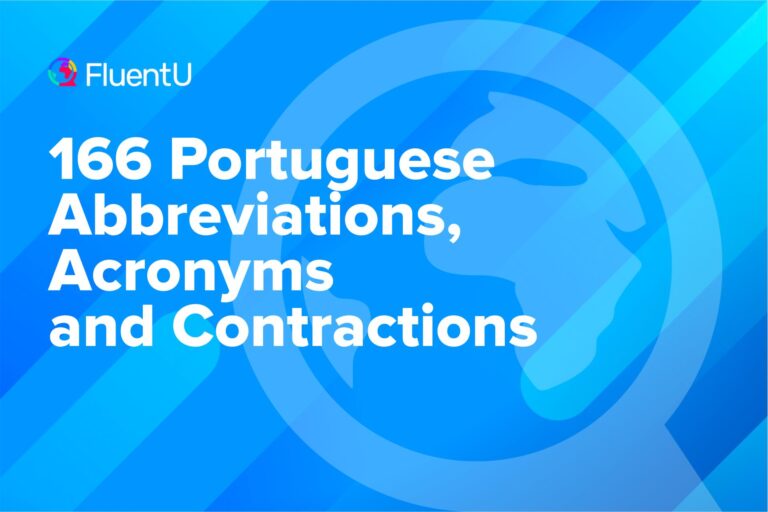12 Fun Portuguese Cartoons for Language Learners

Anyone, regardless of age, can benefit from learning Portuguese with cartoon TV shows.
No, I’m not telling you to part ways with your flashcards, textbooks and immersive techniques—rather, I’m encouraging you to diversify a bit.
Here are 12 entertaining Brazilian and European Portuguese cartoons, along with tips on how to use them for language learning.
Download: This blog post is available as a convenient and portable PDF that you can take anywhere. Click here to get a copy. (Download)
Online Cartoons for Portuguese Learners
The “Dino Lingo” Series (Brazilian and European Portuguese)
This series provides an invaluable resource for Portuguese beginners. Dino Lingo teaches both Brazilian and European Portuguese in a visually engaging manner. Their delightful animated series covers common nouns, numbers and other language essentials.
These cartoons are made especially for young learners of Portuguese, so they employ simple storytelling, repetition and memorable visuals.
BookBox (Brazilian Portuguese)
BookBox creates animated stories for young Brazilian Portuguese learners. Their ultimate goal is to foster a love for reading in all students, while offering insights into the country’s culture and customs. All their stories have Portuguese subtitles that viewers can follow along with as each fable is told.
It’s an all-around great choice for children and ideal for learners of all ages who love a friendly pack of cartoon animals, too.
Practice Portuguese (European Portuguese)
Practice Portuguese is best known for their podcasts, but their animated videos are pretty neat, as well. They alternate between telling tales and showing daily errands and activities.
Compared with the other resources on our list, Practice Portuguese has a humble cartoon collection—but they’re definitely worth tuning into if you want something quite culturally specific.
Authentic Portuguese Cartoons for Native Speakers
Surely you didn’t think we’d leave without showcasing some cartoon productions from Brazil and Portugal! For something with a true local flair, try out these cartoon series:
“Tic Tac Tales” (Portugal)
Including both live-action and animation, this children’s TV series is sure to delight viewers of all ages.
“Tic Tac Tales” starts at a watch shop, where Tobias and Mestre Elias work. Tobias’ musings always prompt Mestre Elias to reminisce and relate a trove of stories, re-enacted by a regular stream of cartoon characters.
You can find clips on the YouTube channel of the show’s developer.
“Romance da Raposa” (Portugal)
Don’t miss this Portuguese classic! “Romance da Raposa” is an adaptation of a novel by Portuguese author Aquilino Ribeiro, and was originally broadcast in the late 1980s.
It follows the adventures and mishaps of a fox called Salta-Pocinhas and his friends. The episodes tell stories about animal life, and are filled with heartwarming life lessons.
“Smilingüido” (Brazil)
You’ll fall in love with the little ants in this cartoon. “Smilingüido” is an evangelical animated series, but it’s not preachy in any way. Rather, each installment teaches valuable life lessons and morals—at times with religious undertones but often more generalized.
“Turma da Mônica” (Brazil)
Seriously, nobody can talk about Brazilian cartoons without mentioning this cultural icon. “Turma da Mônica” started out as a comic book series. It quickly gained traction with children and adults alike and expanded into a larger phenomenon—in fact, there’s even a theme park dedicated to it!
In a nutshell, each story follows a diverse bunch of characters (from suburban kids, to rural folk and indigenous tribes) and throws great life lessons with a sense of humor into the mix. Suffice to say, it’s quite difficult to summarize the series in a few words, so give it a watch.
“O Show da Luna” (Brazil)
This hit Brazilian cartoon is all about a curious girl named Luna. It’s a fun show for learning more about science because Luna’s often out and about looking for answers to her questions, with her younger brother Jupiter and their pet ferret Claudio in tow.
Rainbows, dinosaurs, the Rings of Saturn—you’ll find out all about them here, with each episode featuring a new scientific topic that Luna somehow ends up getting fascinated by.
“Irmão do Jorel” (Brazil)
“Irmão do Jorel” (Jorel’s Brother) was a landmark production because it’s the first Cartoon Network series ever made in Latin America, so if you’re into Brazilian cartoons, you’ve got to watch it.
Set in the 1980’s, it features the funny daily life of Jorel’s brother, whose name you never actually find out. This is meant to poke fun at how invisible he is compared to Jorel, his popular older brother.
You’ll also get to meet the rest of his quirky family, including a very strong-willed mom and a dad who wears a ski mask.
“Historietas Assombradas” (Brazil)
This cartoon brings together light horror and comedy, so it’s great for dipping into Brazilian humor.
Pepe is a mischievous 12-year-old boy who lives with his grandmother, who’s a witch and businesswoman. Together with his friends, Pepe ends up in all sorts of supernatural adventures.
These often involve creatures and legends from Brazilian folklore, like the mula sem cabeça—a headless mule that runs through the night and spouts fire from where its head should be.
“Tromba Trem” (Brazil)
“Tromba Trem” might be a Brazilian cartoon, but it’ll get you learning more about Latin America while also picking up some Portuguese.
The main character here is Gajah, a charming young elephant who’s convinced he’s a lost prince. He’s joined by Duda, a spunky ladybug with a heart of gold, and Júnior, a tapir who’s a bit of a worrywart. Together, they travel across Latin America in a magical, self-driving train.
“Meu Amigãozão” (Brazil)
If you ask Brazilians about their favorite cartoon while growing up, chances are, at least some of them will say “Meu Amigãozão.”
It revolves around a group of kids who each have their own imaginary friend. These are more than just playmates—they actually reflect the personalities and emotions of the kids.
The imaginary friends, thanks to their magical abilities, constantly help the kids overcome obstacles like resolving playground disputes and dealing with losing a pet, so there are plenty of adorable scenes.
Can You Really Learn Portuguese with Cartoons?
Absolutely! In fact, any kids’ show will seriously help you hone those listening skills.
Think about it: Cartoons cater to a young audience that’s still learning the ins and outs of the world around them. These shows have to be simple enough for kids to understand but engaging and educational at the same time (otherwise the kids will just move on to the next show!).
You, as a language learner, are somewhat in the same position—trying to make sense of the Portuguese-speaking world, at a steady and manageable pace.
As with any authentic video or content, getting used to native accents can be a bit overwhelming at first. But the great thing about cartoons is they offer a less intimidating, less complex space for you to practice active listening. Most of the characters you’ll come across will speak at a slower pace than you’d encounter watching, say, a drama in Portuguese or any other Portuguese TV show.
That means you can progressively get used to hearing conversations with a native Brazilian or European Portuguese pronunciation, which will prepare you over time for more sophisticated media and, ultimately, conversation with native speakers.
Sounds pretty great, right? Up next, we’ll show you how to start digging up cartoons for some binge-watching in Portuguese.
Tips for Using Cartoons to Learn Portuguese
Start with cartoons you’ve watched before
Choosing a cartoon in your native language that you know quite well will help you get the ball rolling on this Portuguese learning exercise. This can be much easier than starting out cold with authentic Portuguese cartoons, where you don’t know anything about the plot, characters or context.
For instance, here’s a video from our channel that shows how you can learn with familiar shows like “The Simpsons”:
You can also opt for something slightly more approachable, with simpler cartoons like “Spongebob”:
Try and remember some of your favorite cartoons from when you were a kid. Once you’ve selected a few, do a search for their Wikipedia entries. Then, in Wikipedia, switch the language to Portuguese—you’ll find that most entries will give you the name of the series in Brazil and in Portugal. Make sure to pay attention to the corresponding titles, as they’re often quite different.
Here’s an example: If you look up the Wikipedia page for “Pinky and the Brain,” then you switch the language to Portuguese, you’ll find that the Brazilian name for the series is “Pinky e o Cérebro” and the European version is “Pinky e o Brain.”
Of course, there are exceptions to this rule. You might find that some older cartoons and animated films, such as “Branca de Neve e os Sete Anões” (“Snow White and the Seven Dwarfs”), have the same title in both countries.
Take advantage of subtitles
Now, you’re all set to do a bit of YouTube digging. Where possible, use subtitles and closed captions to your advantage. In the early stages, reading the text as you hear it can help with memorization as well as give you a clearer understanding of what’s being said.
Keeping with our “Pinky and the Brain” example, here’s what a YouTube search brings up for the Brazilian and Portuguese versions. If you’ve come across a cartoon with the same name in both countries, add “Pt-PT” or “Pt-BR” to the end of the title, such as “Pernalonga Pt-BR” (“Bugs Bunny Pt-BR”).
Alternatively, you could always search for “[Portuguese cartoon title] online” on Google. Just keep in mind that copyright restrictions might impact your findings and not all streaming websites are legal.
You can find authentic (and legal!) cartoons, TV show clips and other real-world videos on FluentU.
FluentU takes authentic videos—like music videos, movie trailers, news and inspiring talks—and turns them into personalized language learning lessons.
You can try FluentU for free for 2 weeks. Click here to check out the website or download the iOS app or Android app.
Well, that’s all, folks! We’ve given you all the tools to learn Portuguese with cartoon TV shows, now it’s up to you to animate your learning experience.
Unleash your inner child, get watching those cartoons and don’t forget to apply your new Portuguese vocabulary to the rest of your endeavors.
Download: This blog post is available as a convenient and portable PDF that you can take anywhere. Click here to get a copy. (Download)
And One More Thing...
If you're like me and enjoy learning Portuguese through movies and other media, you should check out FluentU. With FluentU, you can turn any subtitled content on YouTube or Netflix into an engaging language lesson.
I also love that FluentU has a huge library of videos picked specifically for Portuguese learners. No more searching for good content—it's all in one place!

One of my favorite features is the interactive captions. You can tap on any word to see an image, definition, and examples, which makes it so much easier to understand and remember.
And if you're worried about forgetting new words, FluentU has you covered. You'll complete fun exercises to reinforce vocabulary and be reminded when it’s time to review, so you actually retain what you’ve learned.
You can use FluentU on your computer or tablet, or download the app from the App Store or Google Play. Click here to take advantage of our current sale! (Expires at the end of this month.)










